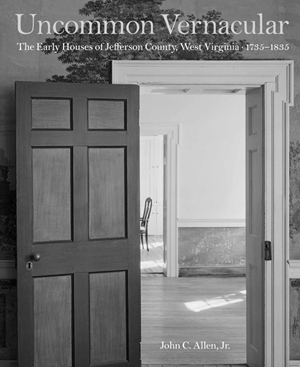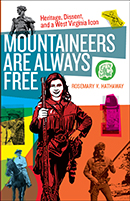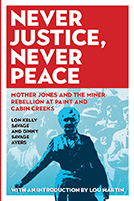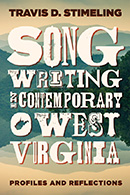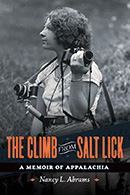Summary
Within the picturesque borders of Jefferson County, West Virginia remain the vestiges of a history filled with Civil War battles and political rebellion. Yet also woven into the historical landscape of this small county nestled within the Shenandoah Valley is an unusual collection of historic homes.
In this fascinating architectural exploration, John C. Allen, Jr. details his expansive seven-year survey of Jefferson County’s historic residences. By focusing on dwellings built from the mid-eighteenth century to the arrival of the railroad and canal in 1835, Allen unfolds the unique story of this area’s early building traditions and architectural innovations. The 250 buildings included in this work—from the plantation homes of the Washington family to the log houses of yeomen farmers—reveal the unique development of this region, as Allen categorizes structures and establishes patterns of construction, plan, and style.
Allen’s refreshing perspective illuminates the vibrant vernacular architecture of Jefferson County, connecting the housing of this area to the rich history of the Shenandoah Valley. Varying features of house siting, plan types, construction techniques, building materials, outbuildings, and exterior and interior detailing illustrate the blending of German, Scots-Irish, English, and African cultures into a distinct, regional style.
Adorned with over seven hundred stylish photographs by Walter Smalling and elegant drawings, floor plans, and maps by Andrew Lewis, Uncommon Vernacular explores and preserves this historic area’s rich architectural heritage.
2011 ForeWord Book of the Year Award Finalist
Contents
- Preface
- Chapter One
From Settlement to Refinement: Houses in Context - Chapter Two
Early Farmhouses, 1735–1815 - Chapter Three
Later Farmhouses, 1815–1835 - Chapter Four
Outbuildings: Farm Structures Serve the House - Chapter Five
Town Houses, 1780–1835 - Chapter Six
Siting and Construction - Chapter Seven
Exterior Features - Chapter Eight
Interior Detailing - Chapter Nine
The End of Local: Arrival of the Railroad and Canal, 1835–1850 - Conclusion
- List of Houses Surveyed
- Notes
- Acknowledgments
- Contributors
- Index
Author
John C. Allen, Jr. works as a preservation coordinator and architectural historian near Shepherdstown, West Virginia. He serves as the chairman of the Historic Landmarks Commission of Jefferson County, West Virginia.
Andrew Lewis, the illustrator, is a licensed architect living in Rectortown, Virginia. His architectural work has been recognized with many awards over his twenty-four-year career.
Walter Smalling, Jr., a Washington architectural photographer,began his professional career with the National Park Service and has worked as a freelance photographer since 1988.
Reviews
During my career at the West Virginia State Historic Preservation Office I have realized that while great architecture exists within the state’s boundaries, not many people knew about it. Now they will. And, although I have visited many buildings included in this book or read their National Register of Historic Places nominations, I could never turn to a reference volume that provided a comprehensive review through floor plans, drawn elevations and photographs. Now I can. John Allen has captured the wonderful architecture of Jefferson County in this, the first publication that documents in great breadth the character and quality of architecture found in West Virginia’s eastern panhandle region of the Shenandoah Valley. Focusing on the period 1735-1835, Allen confirms that architecture found in Jefferson County embraced the popular architectural styles of the era. Each building’s description and analysis is accompanied by meticulous drawings and rich photographs. Walter Smalling, Jr., photographer, and Andrew Lewis, illustrator, have created a wonderful record of this architecture. Both serious student and casual reader will enjoy exploring these pages. I look forward to adding this volume to my collection and sharing it with others.
Susan M. Pierce, Deputy State Historic Preservation Officer
Within this handsomely presented book, author John Allen shares his rapture for the eighteenth and early nineteenth century architectural gems he has uncovered in Jefferson County, West Virginia. Some known, others discovered; some sophisticated for their time and place, others a unique marriage of English precedents from coastal Virginia and German influences that flowed south through the Shenandoah Valley. Beautifully supported by Walter Smalling’s handsome photographs and Andrew Lewis’s excellent elevation drawings and abundant floor plans, Uncommon Vernacular opens for the casual reader and scholar alike a rich though largely underappreciated vein of America’s architectural heritage. In so doing, Allen has struck pure gold."
Dr. William J. Murtagh, First Keeper of the National Register of Historic Places
“Detailed text, extensive photographic documentation, and meticulously drawn plans and renderings collectively present early and extant conditions in a manner that provides a comprehensive historical record.”
Joan M. Brierton, Historic Preservation Specialist
“This book is beautifully and engagingly written.”
Keith D. Alexander, Historic Preservation Program Coordinator, Shepherd University


